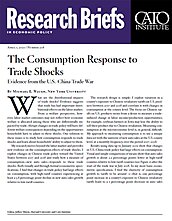What are the distributional impacts of trade shocks? Evidence suggests that trade has had important distributional effects on the labor market. From a welfare perspective, however, labor market outcomes may not reflect how economic welfare is allocated among those who are differentially impacted by trade. Abrupt changes in trade policy will have different welfare consequences depending on the opportunities households have to adjust to these shocks. One solution to these issues is to study how consumption responds to trade shocks and learn about households’ ability to adjust to them.
My research moves beyond the labor market and provides new evidence on the consumption effects of trade shocks. I exploit changes in Chinese trade policy toward the United States between 2017 and 2018 and study how a measure of consumption—new auto sales—responds to these trade shocks. Both visually and through formal econometric specifications, I find that changes in trade policy had large effects on consumption, with high-tariff counties experiencing at least a 3.8 percentage point decline in new auto sales growth relative to low-tariff counties.
The research design is simple: I exploit variation in a county’s exposure to Chinese retaliatory tariffs on U.S. products between 2017 and 2018 and correlate it with changes in consumption at the county level. The focus on Chinese tariffs on U.S. products stems from a desire to measure a trade-induced change in labor income/production opportunities; for example, soybean farmers in Iowa may lose the ability to sell their product due to Chinese retaliation. Measuring consumption at the microeconomic level is, in general, difficult. My approach to measuring consumption is to use a unique data set with the universe of new auto sales at the U.S. county level, at a monthly frequency, over the period 2017–2018.
Results using data up to January 2019 show that changes in U.S.-China trade policy had large effects on consumption. Visual and simple comparisons of means show that auto sales growth is about 2.5 percentage points lower in high-tariff counties relative to low-tariff counties (see Figure 1) after the start of the trade war in July 2018. In my most basic econometric specification, I find the elasticity of consumption growth to tariffs to be around −1—that is, one percentage point increase in a county’s exposure to Chinese retaliatory tariffs leads to a 1 percentage point decrease in auto sales growth. In terms of magnitudes, this elasticity implies a nearly 3.8 percentage point decline in auto sales growth for counties in the upper quartile of the tariff distribution relative to counties in the lower quartile. Under certain assumptions, these estimates imply a decrease in aggregate consumption of up to $54 billion. While modest in aggregate, this effect is concentrated with high-tariff counties experiencing a decrease in aggregate consumption of up to $1,600 per worker.
I connect the decline in consumption with exports and employment growth. Using the same empirical strategy, I find that Chinese retaliatory tariffs reduced a county’s total exports and negatively affected the labor market, especially so for segments of the labor market that are the most sensitive to trade. In particular, I estimate a 1.7 percentage point decline in goods-producing employment growth for high-tariff counties relative to low-tariff counties. This evidence suggests that the decline in consumption is related to the negative labor market consequences caused by Chinese retaliatory tariffs.
What motivates my research is the desire to measure how trade-induced changes in labor income or production opportunities feed into consumption. While prior work has traditionally focused on labor market outcomes, there is no empirical evidence that measures the labor-market-induced consumption effects of trade. Evidence on the response of consumption is important for evaluating the consequences of and appropriate policy responses to trade exposure for the following reason: The consumption response reveals the extent to which households can adjust to trade shocks. For example, if consumption does not change much—even though trade negatively affects the labor market—this suggests that these shocks are insurable and that the distributional consequences and welfare losses associated with exposure to trade are small. In contrast, if consumption changes a lot, this suggests that the labor market consequences are passing through to consumption and that there are important distributional consequences for welfare associated with trade. My main result is more consistent with the latter interpretation: Chinese retaliation is leading to welfare losses.
A second motivation is simply to understand the economic consequences of the U.S.-China trade war. A unique feature of the data used is the combination of geographic detail and high frequency. Given the many abrupt changes in policy (and announced policy), high-frequency data provide a unique perspective on how communities and households are quickly reacting to these changes. The geographic and high-frequency nature of my paper complements related analyses of the U.S.-China trade war that study the aggregate effects of tariffs on U.S. imports and prices of goods from China. I focus on a different mechanism: how Chinese tariffs on U.S. exports affect consumption, depending on changes in a county’s exposure to the retaliation. While the focus is on these distributional issues, a simple back-of-the-envelope calculation suggests that this mechanism—reduced consumption in response to Chinese retaliation—is as large as the aggregate effects.
NOTE:
This research brief is based on Michael E. Waugh, “The Consumption Response to Trade Shocks: Evidence from the U.S.-China Trade War,” NBER Working Paper no. 26353, October 2019, http://www.nber.org/papers/w26353.
About the Author

This work is licensed under a Creative Commons Attribution-NonCommercial-ShareAlike 4.0 International License.
